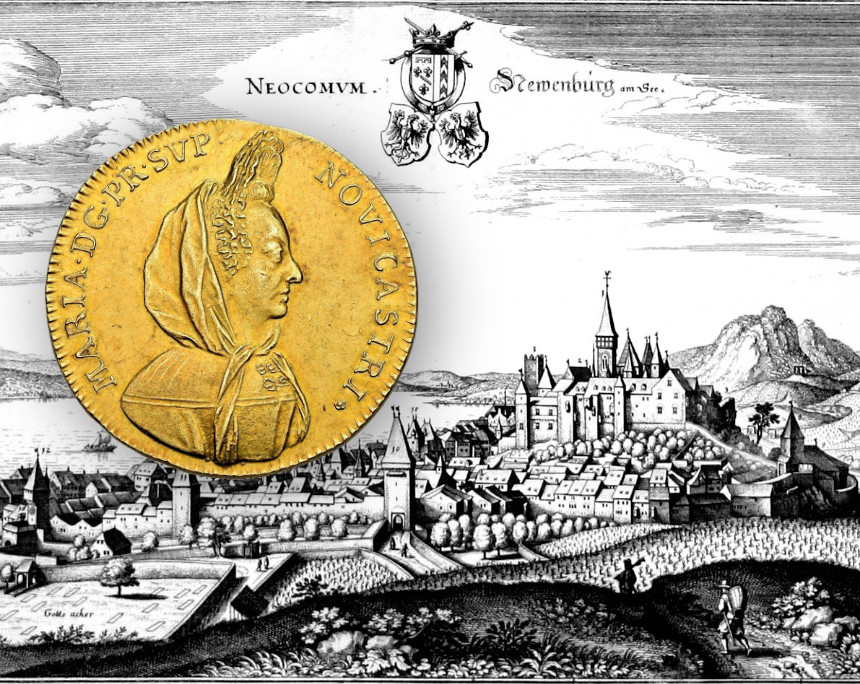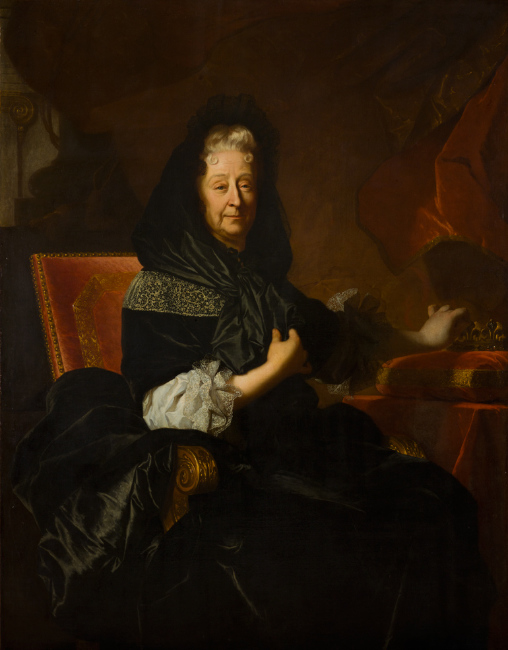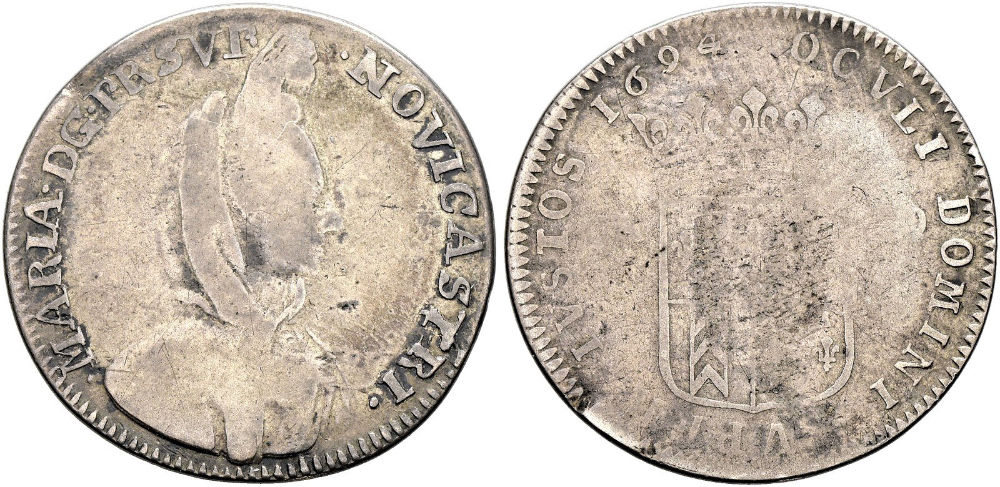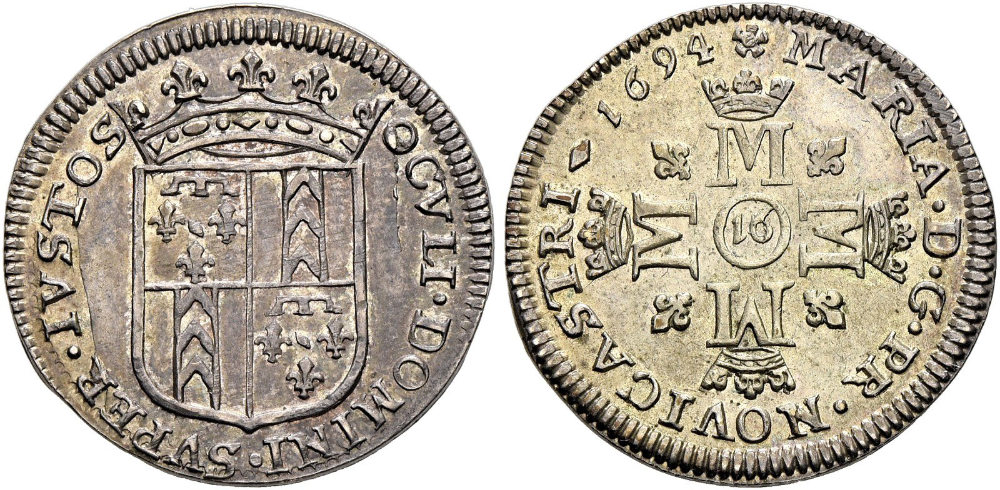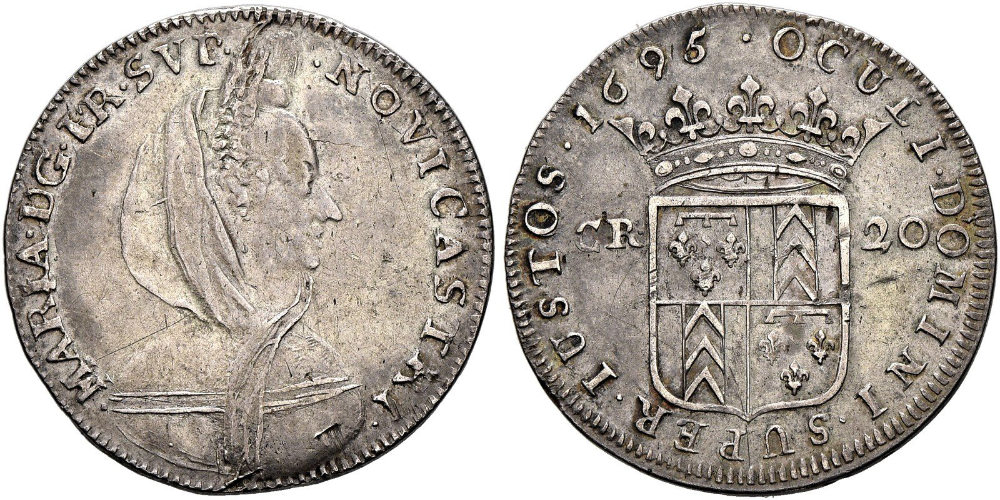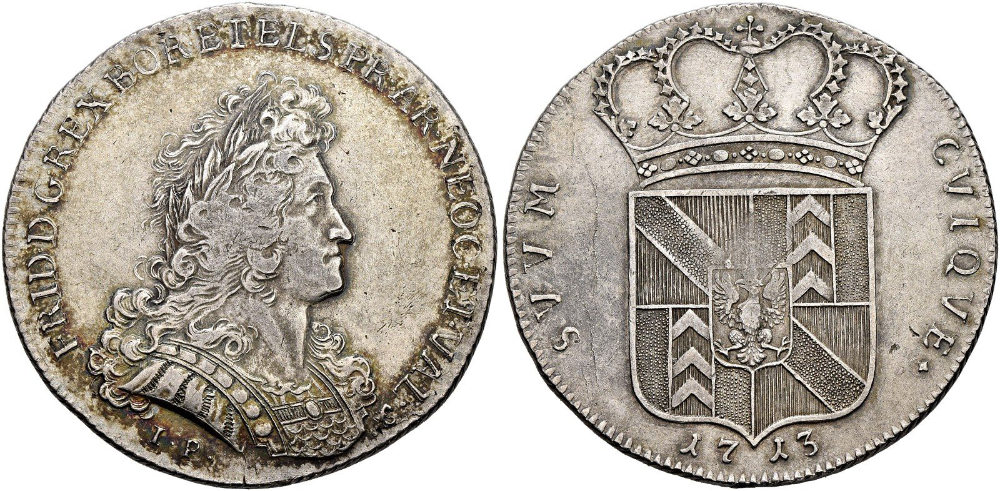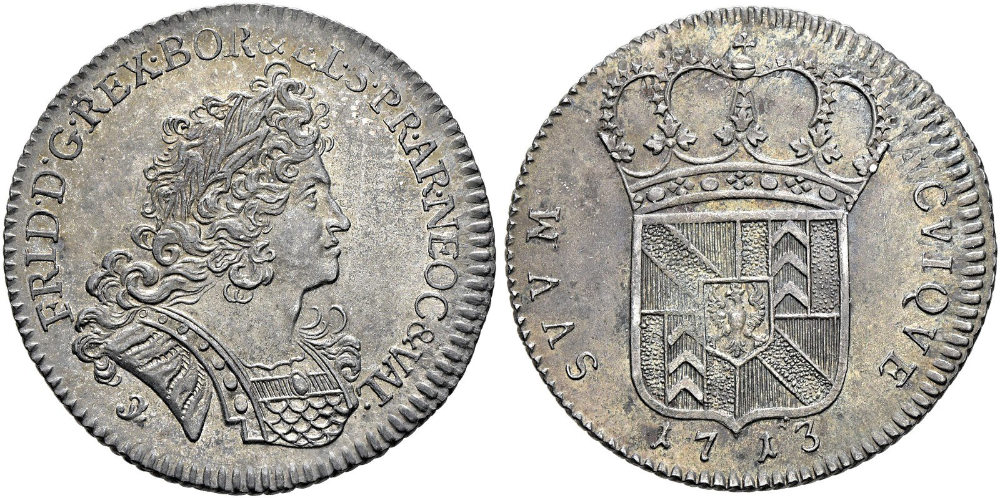Why Neuchâtel Is Not Part of France Today
by Ursula Kampmann on behalf of SINCONA
It was a close call – Louis XIV would certainly have swallowed up Neuchâtel in today’s Switzerland if it had not been for Marie de Nemours’ fierce insistence on her rights. We explain the political situation and introduce you to the princess and her coinage. All the pieces shown come from the Bürki Collection and will be on offer in SINCONA’s Auction 95 on 24 October 2024.
Content
Why is the world structured the way it is? Why is there a border here and not 2 kilometres further north, south or somewhere else entirely? Why do people speak German in one part of Switzerland, French in another, and in some places both? Everything that seems so obvious to us today has its roots in history. We will tell you why Neuchâtel is not a French department and why its inhabitants speak both French and German. To do so, we will take you back to the 17th century.
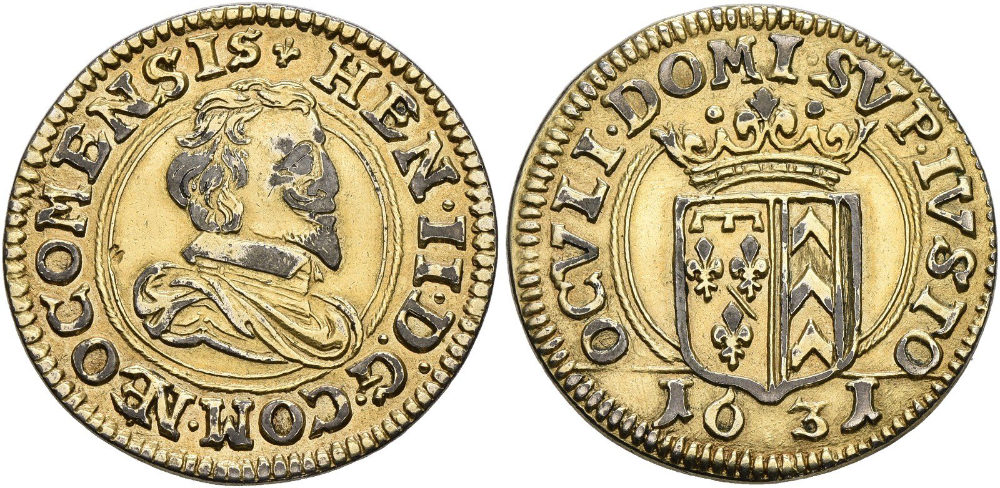
Henri II d’Orléans-Longueville, 1595-1663. Dicken 1631, Neuchâtel. Extremely rare. Gilt. Very Fine. Estimate: CHF 12,000. From SINCONA Auction 95 (24 October 2024), No. 4355
Henri II d’Orléans-Longueville
Let us begin with Henri II d’Orléans-Longueville, a powerful French prince. He held the titles of Prince and Peer of France, and had French possessions for which he owed fealty to the king. But he was also prince of the independent dominions of Neuchâtel and Valangin, which had been ruled autonomously by the House of Orléans-Longueville without any connection to the French king since 1504.
Henri wanted to keep things as they were. That is why, as head of the French delegation at the negotiations for the Peace of Westphalia, he fought vehemently for the independence of the Confederation. After all, he needed the Confederation as a political counterweight to Louis XIV. In fact, he even tried to integrate Neuchâtel into the Confederation. This did not succeed. Neuchâtel kept the status of an associate member with particularly close ties to Bern.
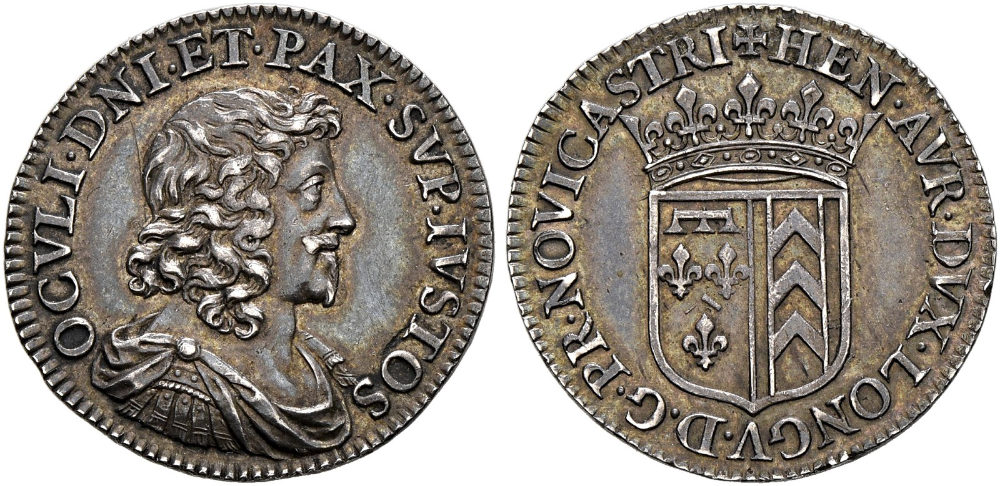
Henri II d’Orléans-Longueville, 1595-1663. 10 Kreuzers n.d. (1551), Paris or Neuchâtel. About Mint State. Estimate: CHF 800. From SINCONA Auction 95 (24 October 2024), No. 4358
In this context, it is understandable why Henri II insisted on having his own coins minted in Neuchâtel, even though it would have been much cheaper for him to use French money, as so many other princes did. The coins were a sign of his independence. Just as Henri II demanded that his citizens could not go to the French courts to challenge his decisions, he wanted to emphasise his authority over the money in circulation by minting his own coins.
But what did the administration of Neuchâtel look like under Henri II? Only if we have an idea of its organisational structure can we understand the role of Marie de Nemours. Although decisions were officially taken at the prince’s court, this court was not located in Neuchâtel but in the much more splendid residences of the ruler’s possessions in France. The Council of State, whose members came from the Neuchâtel patriciate, became the link between the prince and the citizens. In this context, it is worth remembering one name: Georges de Montmollin. He was one of the prince’s closest advisers, consulted him at court, carried out his orders in Neuchâtel and was ennobled by Henri II in 1657.
Questions of Succession
Henri II died on 11 May 1663. He was succeeded by his eldest son, Jean Louis. However, the latter wanted to become a priest and passed on his inheritance to his younger brother Charles Paris. Therefore, Charles Paris became Prince of Neuchâtel in 1668, a title that was probably of little interest to the young hotshot. That year he fought the Turks off Candia, competed for the throne of Poland, and generally had very ambitious plans. All these plans met an untimely end on 12 June 1672 in the battle for the Dutch fortress of Tolhuis. Charles Paris died childless, leaving the question of succession open again.
Marie de Nemours
This brings us to the woman at the centre of this article: Marie de Nemours. The eldest daughter of Henri II, she is described as a highly educated, strong woman who insisted on accompanying her father to the peace negotiations in Münster. She fought against the French King in the Frond, and published her view of the events in her memoirs at the end of her life.
She married Henri II of Savoy on 22 May 1657 and probably regretted this decision on the very day of the wedding. Her husband was ill and died less than two years later without Marie even becoming pregnant. At this point, she had had enough of marriage. She was not to marry again and took care of her extensive estates herself.
Intrigues, Aspirations and Power Struggles
So when the question of who was to inherit the rule over Neuchâtel had to be settled in 1672, being the eldest daughter of Henri II, Marie de Nemours also laid claim to the inheritance. As mentioned above, she was considered an energetic woman; and the politicians of Neuchâtel, such as Georges de Montmollin, were not interested in an energetic ruler. The court of the three estates of Neuchâtel avoided the decision by appointing Louis XIV as arbitrator. The latter argued in favour of reinstating the pliant priest Jean Louis as prince. After all, this opened up possibilities: Jean Louis was showing signs of mental confusion and his mother, who had been entrusted with the regency, had long since retired to a convent. This meant that the Council of State of Neuchâtel could do as it pleased. The unfortunate thing was that the appointment of Louis XIV as arbitrator gave him the opportunity to try to take supreme control of Neuchâtel. This mistake could have been fatal.
Jean Louis’ mother died in 1579. Therefore, a new guardian had to be appointed, and Marie de Nemours was able to hold her ground. One of her first decisions was to remove Georges de Montmollin from office. A terrible mistake. The well-connected politician brought Louis XIV back into the picture, and the latter transferred the guardianship to Louis II of Bourbon-Condé in 1582. Montmollin was very happy with this decision. After all, Bourbon-Condé had already retired to his Château de Chantilly, where he spent his time with his collections. He immediately reinstated Montmollin and let him do as he pleased.
Le Grand Condé died in 1686. Thus, his office as regent of Neuchâtel passed to his son, who was readily referred to as Le Fol Condé by his contemporaries. The latter fell out with Georges de Montmollin in 1693. And this was not the only reason why the situation was very different when the actual prince, mentally deranged Jean Louis, died in 1694: Louis XIV had issued the Edict of Nantes in 1685, showing what absolutism really meant – an absolute prince was not bound by any agreement. Woe to any territory that tried to preserve its independence under his rule!
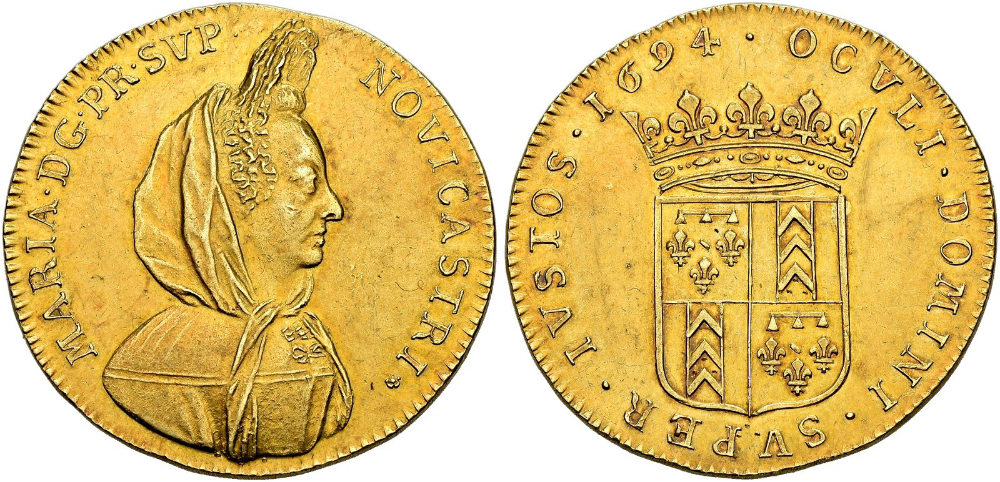
Marie de Nemours, 1694-1707. Double Pistole 1694, Neuchâtel. About Uncirculated. Estimate: CHF 80,000. From SINCONA Auction 95 (24 October 2024), No. 4359.
The Triumph of Marie de Nemours
The court of the three estates ruled therefore that Marie de Nemours, who was 69 years old by then, was her brother’s heir. Marie had triumphed. Finally! She immediately went to Neuchâtel and took up residence in the castle. Her coins from 1694 belong in this context. She presented her portrait on a magnificent Double Pistole, which will be offered on 24 October 2024 as part of the Bürki Collection. The translation of the obverse circumscription reads: Marie by the grace of God, supreme prince of Neuchâtel. The reverse shows the crowned coat of arms of the House of Orléans-Longuevilles and that of Neuchâtel. The circumscription – The eyes of the Lord are on the righteous – is taken from Psalm 33, a hymn praising God for the defeat of all enemies.
The fact that Marie de Nemours had coins minted at all can be seen as a sign. With the exception of two ephemeral issues in 1666 and 1668, no coins had been minted in Neuchâtel since the reign of her father Henri II. Her contemporaries immediately understood the message: Marie de Nemours, like her father, was a sovereign that was independent of France.
For this reason, she not only commissioned the production of magnificent gold coins such as the Double Pistole issues, which were mainly used as gifts, but also had circulation money minted to be used by ordinary people at the market.
The Fight Against France
Of course, Le Fol Condé challenged the ruling with the support of Louis XIV. He demanded an independent court of arbitration be set up, knowing the Sun King would support him. But this was exactly what most of the nobility in Neuchâtel feared. They had a good idea of what would happen if he asserted himself as ruler. What they feared was to happen in 1702 – only a few years later – to the Principality of Orange: Louis XIV proclaimed Bourbon-Condé to be the heir; the latter occupied the principality with his army, then transferred it to the French crown, and this is how the independent Principality of Orange became part of France.
The fear of such a fate brought all of Marie de Nemours’ former opponents on her side. A great assembly of all the estates of Neuchâtel was convened and, on 24 April 1699, this assembly solemnly confirmed the ruling of the court of the three estates, recognising the rule of Marie de Nemours.
Louis XIV was left with nothing more than an inconsequential demonstration of power: As an owner of French fiefs, Marie de Nemours had to obey him if she did not want to be deprived of these possessions. In January 1700, Louis banished her to her manor in Coulommiers, located a two days’ journey from Versailles. She would only regain her freedom of movement if she submitted to his will. Louis must have seriously misjudged Marie de Nemours’ character if he thought that she would do as he wished. She refused to change her will.
And while Louis XIV was still annoyed by her stubbornness, Georges de Montmollin was preparing his final coup: transferring the rule of Neuchâtel to the House of Hohenzollern.
Frederick I of Prussia, Prince of Neuchâtel
Marie de Nemours died childless on 15 June 1707. After her death, 19 heirs are believed to have made claims for the rule of Neuchâtel. Nine of them were admitted by the court of the three estates. In the end, the court decided in favour of Frederick I, King in Prussia. The reason is obvious: they could be sure that this ruler would not be influenced by France!
Louis XIV was outraged. He immediately planned for his army to occupy Neuchâtel. The only reason why this did not happen was that too many resources were tied up in the War of the Spanish Succession. Neuchâtel got lucky because its independence became an issue during the peace negotiations that were to end this war. In 1713, France gave up its claim to Neuchâtel for good in the Treaty of Utrecht.
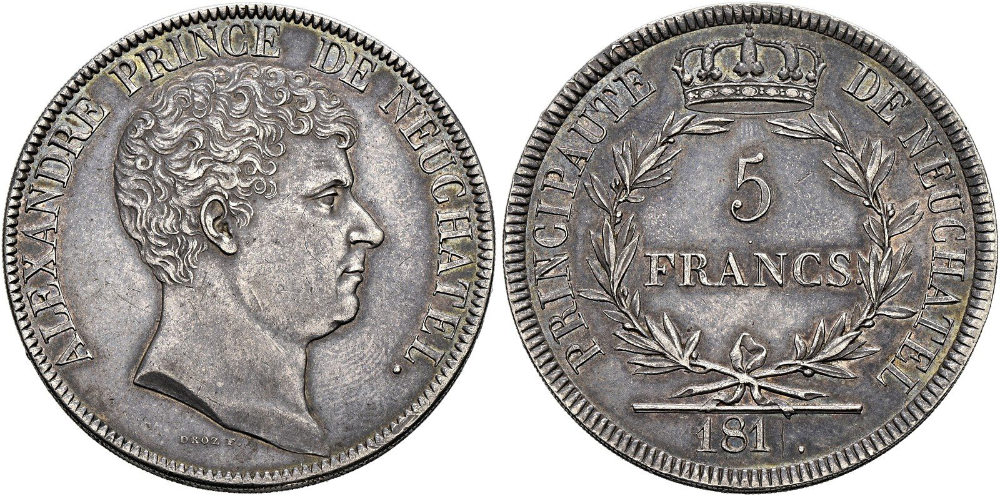
Louis-Alexandre Berthier, 1806-1814. 5 Francs 181(3), Paris. Very rare. About Mint State. Estimate: CHF 12,000. From SINCONA Auction 95 (24 October 2024), No. 4405.
Neuchâtel only experienced a brief period of French rule during the Napoleonic Wars. But that is another story.





